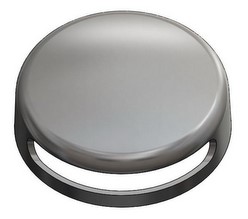The functionality doctrine remains strong. In a recent decision, the Trademark Trial and Appeal Board relied on the doctrine of functionality in finding that the product configuration mark at issue was unprotectable under Section 2(e)(5) of the Lanham Act.
In re WCM Industries, Inc., 2020 USPQ2d ______ (TTAB 3/17/20) (not citable) involved WCM’s attempt to register a product configuration mark for a drain overflow cover for “plumbing products, namely, a bathtub overflow drain cap” in Class 11. The applied-for mark (shown below) consisted of a cap with rounded edges and a flat face with a smooth cylindrical sidewall that extended from the face at a perpendicular angle.
The examining attorney refused registration on the basis of functionality under Section 2(e)(5) of the Lanham Act, as well as under Sections 1, 2 and 45 of the Lanham Act finding that the product design was nondistinctive. On appeal, the Board agreed with the examiner that the drain overflow cover was de jure functional. Section 2(e)(5) of the Lanham Act provides that the registration of a product design be denied if it “comprises any matter that, as a whole, is functional.” Generally, a product design is found to be functional in a utilitarian sense if it is (1) “essential to the use or purpose of the article;” or if it (2) “affects the cost or quality of the article.” Id. at 3, citing TrafFix Devices Inc. v. Mktg. Displays Inc., 532 U.S. 23, 58 USPQ2d 1001, 1006 (2001) (quoting Inwood Labs., Inc. v. Ives Labs., Inc., 456 U.S. 844, 214 USPQ 1, 4 n.10 (1982)).
In making its determination, the Board weighed WCM’s utility patents for overflow plumbing devices heavily in favor of functionality in finding that the patents embodied the main features covered by WCM’s trade dress application. The Board specifically rejected WCM’s argument that although the utility patents protected the functional aspects of the overflow cover, they did not protect the face and sidewall specifically covered by the product configuration trademark application and, therefore, nothing in the utility patents indicated that the shape of the product was essential or made the cover function better or more efficient; therefore, the patents did not support a finding of functionality of the product configuration.
The Board, however, disagreed and held that the disclosures and claims in the utility patents specifically stated that the elongated slot allowed for an increase of the fluid flow capacity of the cover and reduced overflowing the bathtub, which supported a finding of functionality. Additionally, the patent claims supported a finding that the smooth cylindrical face made the installation easier, which also weighed in favor of a finding of functionality of the product configuration. Importantly, the Board found that each element of the applied-for product configuration directly corresponded to an essential element claimed in WCM’s utility patents. For these reasons, the Board held that the overall configuration was functional and affirmed the examiner’s refusal to register the trade dress under Section 2(e)(5).
The key takeaway from this decision is to carefully consider the impact that a finding of functionality will have on registrability and/or your position in litigation and make sure you feel confident that the product configuration is non-functional.




 />i
/>i


